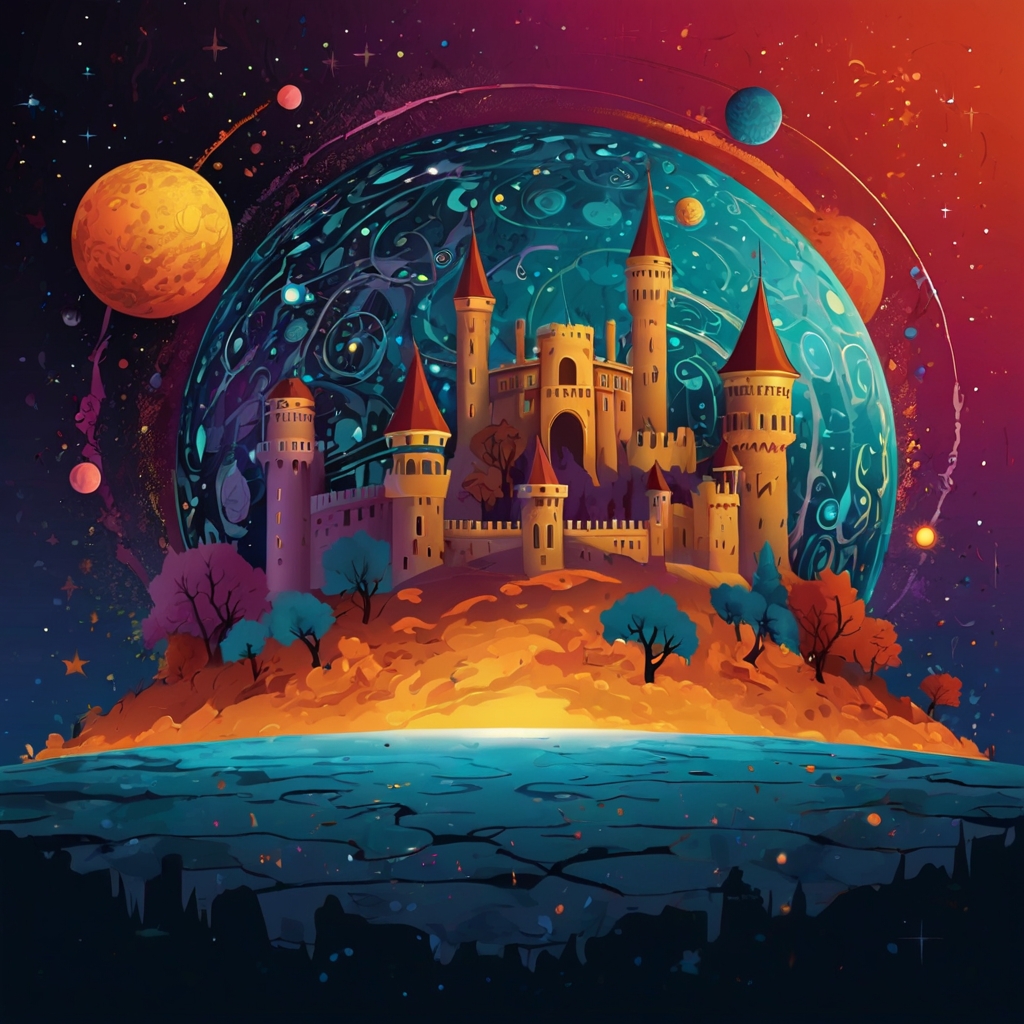
Hello, My World!
by Kaelon
On June 2, 1989, my family moved across the State of Florida and in an instant, my world was rocked. As a nine year old now living in Tampa in the middle of the rainy Floridian Summer, I quickly found myself at ‘ground-zero’ - a creative loner who was friendless and forlorn. So, I did something creatively spontaneous: I created a fantasy world online and invited anyone who wanted to join me in writing collaborative stories to do so.
At the time, the ‘Internet’ didn’t exist, and getting ‘online’ was limited to local dial-up bulletin board systems, or BBS’es, or one of a small number of proprietary services. One of those services was Prodigy, a nascent partnership between IBM and Sears to create a sort of online shopping mall with news and games - and much has been written about just how far ahead of its time this service was (check out this Flickr album for incredible screenshots of what this place was like). But an unexpected side effect of offering its approximately 6 million members dozens of bulletin boards for discussion is that it created a ripe environment for the creation of massive online communities. And so, I started posting notes to create a fantasy world where I, a nine-year-old boy, was really a magical king and invited anyone who wanted to join me in a game of text-based narrative make-believe to join my fictional kingdom.
Thus my world was born.
Gen. 1: Origins (1989)
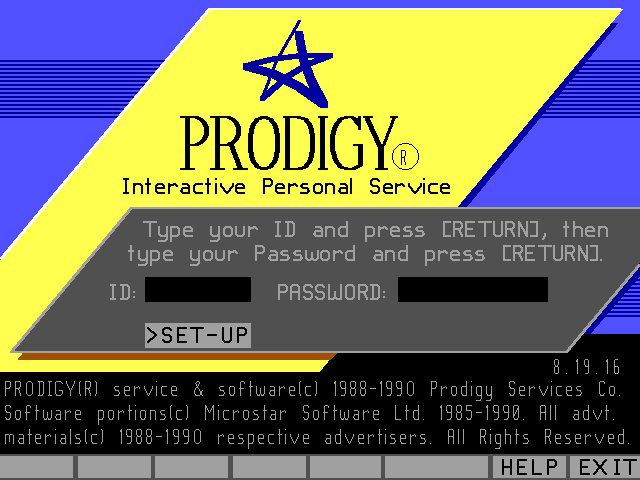
It was a free-form, fantastic, and farcical creation where all of us would post locations and then write stories about how we would interact with one another in these places. And it was incredibly popular. Within a month, dozens of people had become dukes and duchesses, knights and pirates, witches and wizards, and adventurers all telling stories and building an epic saga of how this make-believe kingdom arose from nothing. I was genuinely taken aback at how truly un-alone I was: there were tons of people just like me - creative writers, role players, and gamers just looking for a place to express themselves and make friends.
All of us were on the bleeding-edge of what it meant to create content over an electronic medium. Sure, people had been playing games like these - from the childhood games of make-believe to the rule-bound table-top role playing games that prevailed among nerds in the 1970s and early 1980s. But it seemed like we had struck magic, and everyone wanted to be a part of this adventure. We were repurposing subjects (collections of notes) to serve as historic landmarks in an ever-evolving shared-creation, and when stories across these locations were written and read, it was as if a new reality was being imprinted in realtime. We even were awarded our own ‘Topic,’ a prized top-level discussion area for the thousands of posts we were all making every month. It was an incredible achievement when access to the service had an hourly charge; people were hooked on this experiment.
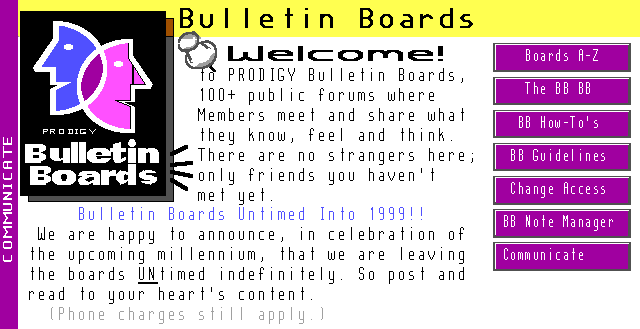
And just like every social experiment, it was filled with the messiness of the drama of its participants. From adolescent angst-filled romances to hyper-competitive squabbles, and pretty soon, the story of Aelyria / Alleria - even if it wasn’t called that yet - was a political one, complete with systems of government and dramatic warfare since, after all, everyone wanted to be king, and I was certainly not going to give up the throne without a fight. But how exactly could people ‘fight’ over bulletin boards, where there weren’t armies or resources or even ‘land’ to conquer and hold? We used our imaginations and, even amidst the raucous tangle of rambunctious teenagers, still maintained a sense of decorum that we could only write about what the characters and places that we each controlled could do. This growing system was quickly given a name, to contrast it to the lengthy and slow turn-based dungeons-and-dragons sessions played over e-mail (the so-called “play-by-email.” It was termed Play by Post.
Gen. 2: The World Wide Web (1996)
By 1995, with many services like AOL (America Online), CompuServe, and GEnie connecting to the Internet, Prodigy followed suit beginning with email and UseNet newsgroups (and Aelyria even had some early alt.rpg newsgroups to organize posts), but the experience was still anchored in the visual of the post-and-response system that members had created on the bulletin boards. So when Prodigy finally connected to the World Wide Web, the system of hypertext markup lent itself perfectly to what we needed to introduce Play by Post gaming to the entire world. Within a couple of years, I had taught myself HTML and Perl - a scripting language to make the static pages truly interact-able - all in the service of bringing this world of make-believe to larger audiences.

Matt Wright’s WWWBoard and later Darryl Bergdorf’s WebBBS were easily modified to support a post-and-response dynamic, with each instance of the entire bulletin board used to represent a major location (cities, palaces, the countryside, etc.). The game world amounted to dozens of fantasy realms and thematic regions. On the web, formalized rules started to emerge so that the community could manage thousands of new participants that started to overwhelm the previously informal methodology. Key contributors started to volunteer to run these rules and we called them Game Masters. GMs formed an essential backbone that opened the door to skill-based character development, formalized systems for advancement, and the development of extremely detailed, intricate storylines that would rival any fantasy epic.
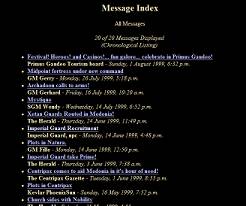
Gen. 3: Newfound Fame (1997)
In 1997, MSNBC’s Soledad O’Brien featured the website and its thousands of players on her cable television digital culture show, The Site. In 1999, Electronic Gaming Monthly wrote a few blurbs about the site and both Yahoo! and Netscape featured it on its hot site listings.

Web 1.0 was still in full swing, but with now over a hundred in-game locations and hundreds of thousands of posts, the website’s ad-hoc infrastructure strained under the demand. I migrated Aelyria from the many threaded-nested webboards to the classic linear Ultimate Bulletin Board by Infopop (later Madrona Park), and this scale allowed the Play by Post movement to lay out a template that would be imitated by countless other communities seeking to emulate their own worlds, design their own games, and write their collaborative fictions. The upgraded interface allowed for increasingly complex and intertwined storylines, rich and immersive world-building, and a truly thriving community.

Gen. 4: Nu-Alleria (2000)
A recurring theme would start to express itself: Aelyria would become a victim of its own success. While I was a life-long computer-addict (a consequence of having grown up in a 1980s household as a child of two computer programmers!), I had reluctantly become a full-time engineer on the bleeding-edge of technology. From shared hosting to fully dedicated servers, the “cloud” of server-farms and third-party platforms would be many years away, and so, one layer of technology would show its obsolescence as our community would break through barriers: concurrent users, simultaneous posts, real-time content submissions.

Fans were devoted to this creation, and a lonely childhood escape was now truly a shared creation. When one website would crash, members would dive into creating a fan site and its extended community of volunteers and contributors would keep the dream alive. Continuing storylines and tangential plots could be improvised as hundreds of players started building extensive character histories and founded guilds to their collectives of players. The Nu-Alleria website, in particular, hosted on the ezBoards, was one such continuation, affording us a collective breather to build a platform that was more sustainable. World-building was more than just creative-writing and role-playing; it was platform-engineering to sustain a community that depended upon this framework for an emotional, intellectual creative outlet.
Gen. 5: Web 2.0 (2001)
Websites across the globe started rethinking their information architecture, from page layout to underlying infrastructure, and the era of Web 2.0 was upon us by 2001. I built a new website powered on a robust PHP front-end with a dynamic MySQL backend, and it allowed our community to feature in-game events, world information, and relevant plot lines presented contextually to players based upon their interests. I inaugurated the use of vBulletin from Jelsoft at this time, layering different dynamic layouts for distinct pieces of content: from world information to character sheets.

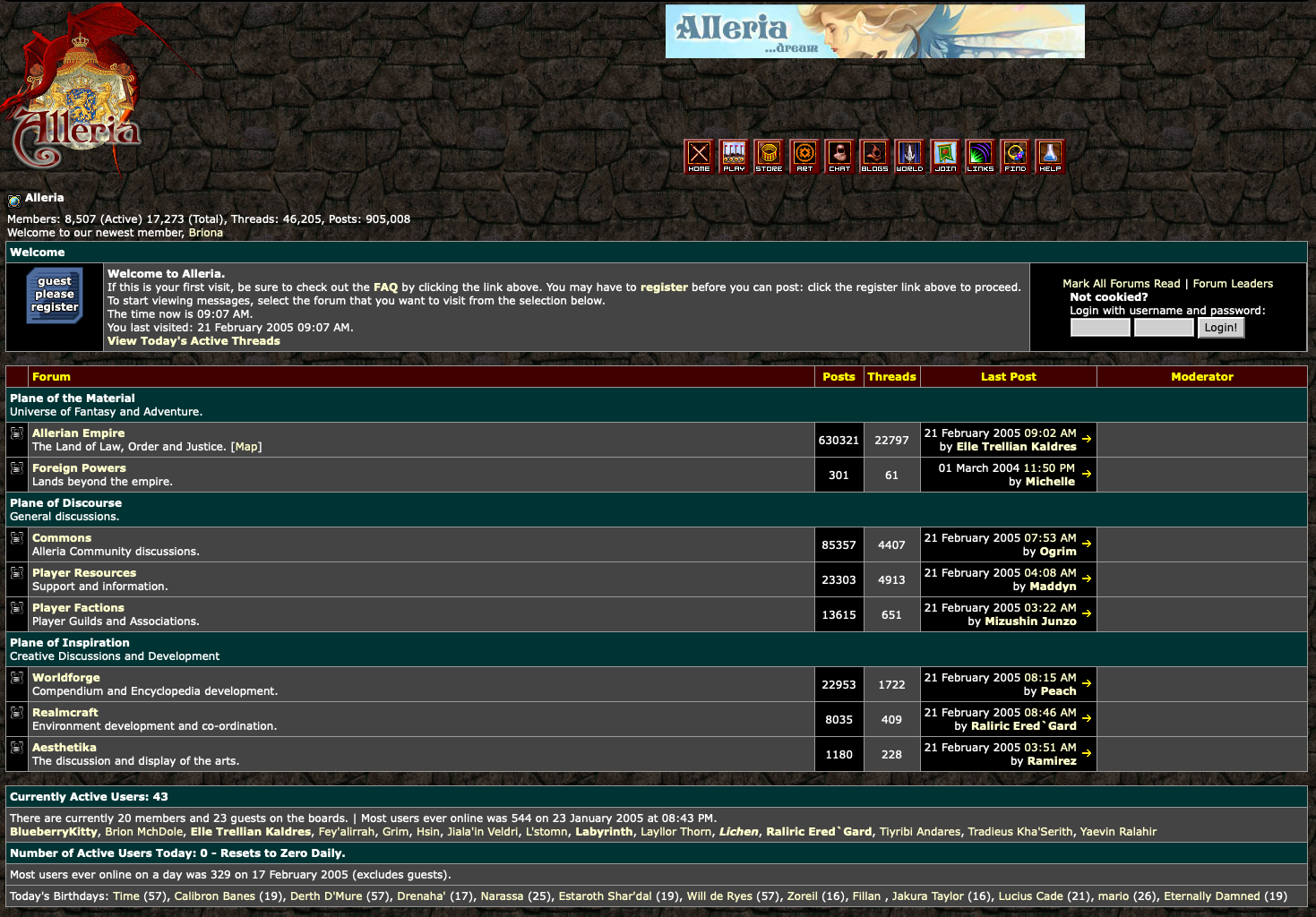
Publishing Workflows
By 2005, Massively multiplayer online games had proliferated in the years earlier, from Verant’s EverQuest to Funcom’s Anarchy Online. So, too, did a dramatic interest surge among writers, artists, and musicians in genuine collaborative world-building. There was an enduring demand for Aelyria and Play by Post gaming in general, and so we deployed Drupal on top of the forums to better facilitate authoring and publishing workflows. Contributor teams now extended beyond game masters, and moderation included every facet of the creative process and community engagement continuum. Thousands of team members specialized in developing polished, detailed, authoritative works. Collective content creation standards reached new heights, with an increasing emphasis on professionalism through research and creative dedication.
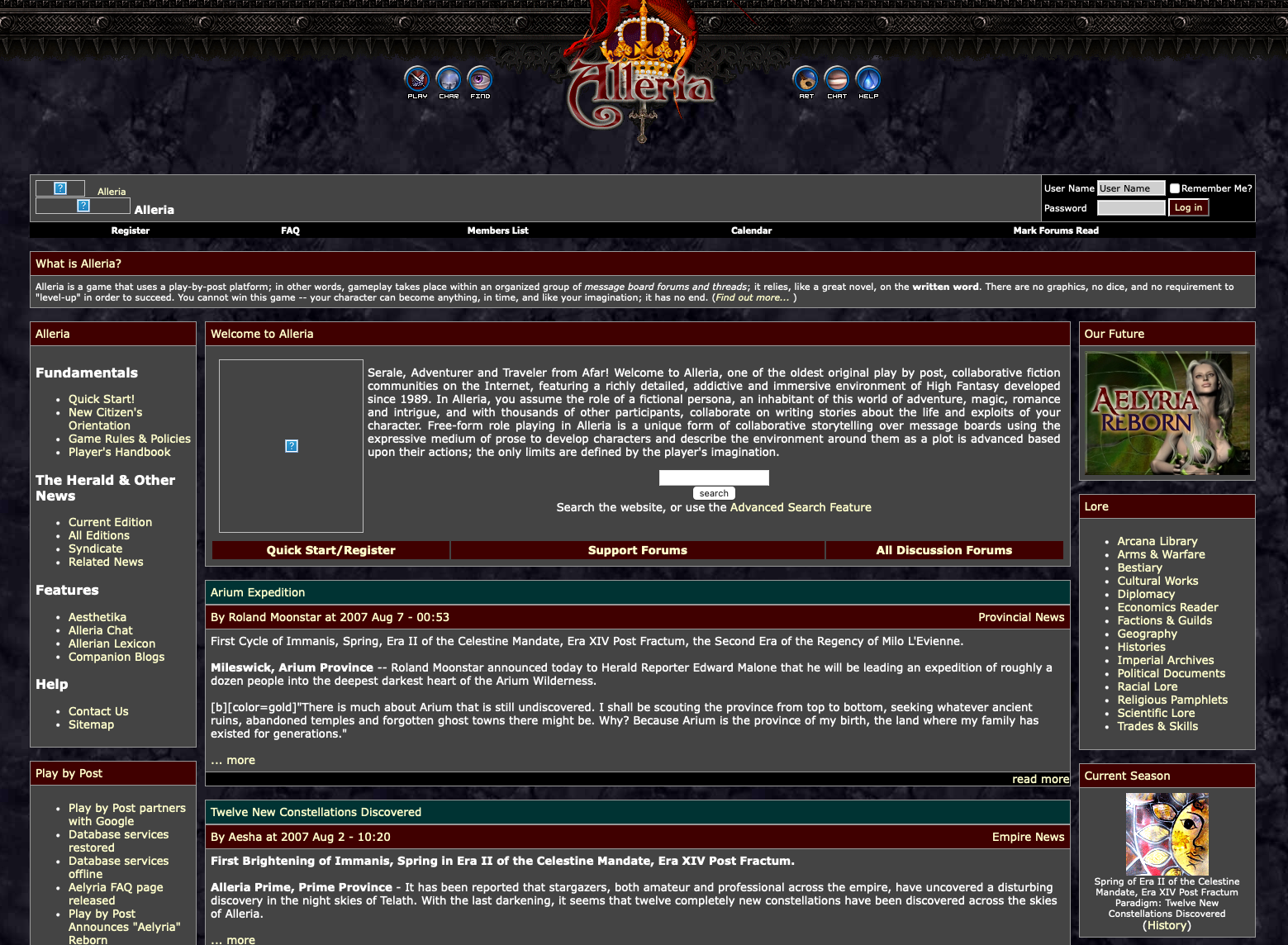
The community spearheaded the creation of a conceptual design studio, the Worldforge, that truly democratized the creative development process. Just as social media truly began to take off, Aelyria began to see an increasing need for more mobility and varied forms of expression among its increasingly diverse and cross-generational userbase. What had started as a digitized game of make-believe among kids and young adults had flourished into a community of thousands, all sharing in the joy of building something that had endured for decades.
Gen. 6: Engines of Creation (2007)
In 2007, I had a once-in-a-lifetime opportunity to relaunch Aelyria as a self-sustaining business. The heyday of Internet advertising was among us, and investors from every corner wanted in on any website that even remotely resembled a winning proposition. You’d hear the phrase “content is king” often muttered, and I was introduced in my then-hometown of Boston to a ragtag bunch of venture capitalists who essentially encouraged me to turn my passion into my full-time job. It was an irresistible lure, and I took it.
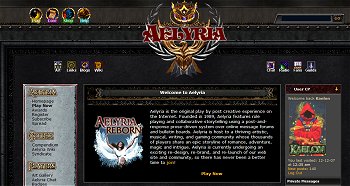

Relaunching Aelyria on an upgraded version of the vBulletin forum system with layers of modifications and hooked-on extensions allowed me to extend the community on the same database that had been powering our contributions for the past couple of website generations. Instituting Web 2.0 conventions, emphasizing social networking, sharing of content, profile pages, and search engine optimization, Aelyria became more relevant and actionable for each member. But, like all boom-and-bust cycles, the Internet advertising age collapsed in 2009. Fortunately, member-contributed paid-subscriptions (again, years before services like Patreon would ever go mainstream) ensured the website could be ad-free and self-sustaining. And while there were never more than a couple hundred such patrons (or "Companions," as I called them), it was enough to allow me with a mixture of regret and relief to push back from my life’s creative passion and realized it should no longer be a veritable enterprise.
The Future
Aelyria had been on the same infrastructure for over twelve years with really minimal modification. Upgrades of vBulletin long ran their course, and the website's runway for using this system reached a critical fault in 2019 when new software publishers end-of-life'ed the platform. By then, there were millions of pieces of content contributed across engines, and when the last PHP version was depricated, much of the site's functionality became obsolete and non-functional. This generation had run its course and went offline for now.
Aelyria began as my creation long ago, ostensibly when the first friends that I sought to make back in between school years in 1989 hopped online on Prodigy and joined me on the Games BB (and later, the Role Playing BB) to tell stories. Someone once described our fiction as “the Princess Bride meets Red Dwarf,” as the content was always inspired by popular culture and highly derivative, but it was arranged with the right mixture of comedy, drama, irreverence, and wit to be relevant and compelling. I maintained the creation's craft by conducting the orchestra of the cosmos that was everyone who ever had and ever would be a part of its unfolding story. Because of my stewardship, it has also been, and will continue to be, incredibly long-lived.
While I know that I have never been alone in this passion, I am uniquely responsible as the Creator for building a future that holds an endless quest with infinite rewards as we traverse the tales we weave together. And in that spirit, it is and always will be a labor of love that is to be continued.